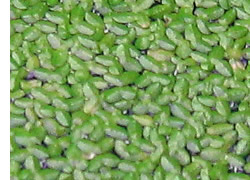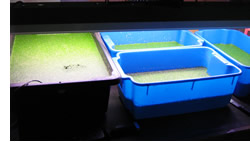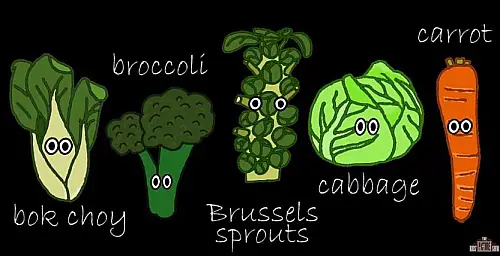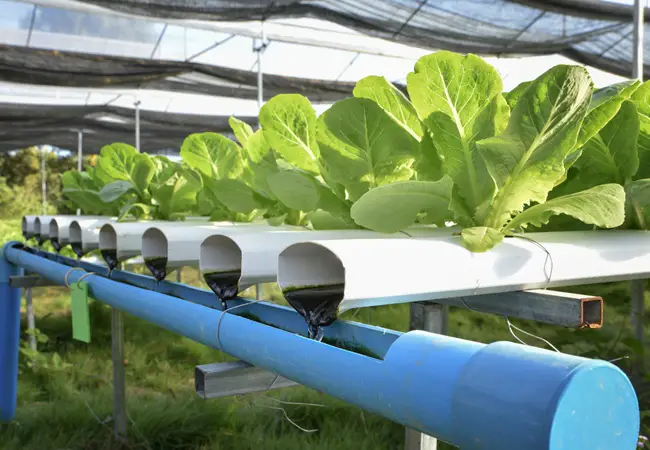Although we will focus on growing vegetables on this site, nothing stops you from growing other types of plants as well. Most things grow well in a well-tended aquaponics system, but you should be careful that you don’t inadvertently try to grow something toxic to your fish.
Our focus is on vegetables simply because the objective of this website is to show the reader how to grow good quality organic vegetables and fish in their own backyard and enjoy the long-term savings and health benefits that food from an organic garden provides.
As with hydroponics, the best vegetables to grow in an aquaponics system are leafy or bear fruit. Root crops reportedly do not fare so well in some mediums though this is for the individual to decide, and I advise you to experiment on a small scale if you feel the inclination.
The Grow Bed
The grow bed is a very critical part of your aquaponics system. Not only does it provide a place for your vegetables to grow, but it performs the important task of biofiltration, providing a home for your bacteria colonies and ensuring that the excess nitrates are removed from the water that your fish live in.
The vegetables themselves perform the final step in the process of removing the ammonia from your system. For in-depth information on this process, please consider reading our page on bacteria.
Ideally, your grow bed should be the same capacity as your fish tank. Though, of course, it does not need to be the same shape. So if you have a 500-liter fish tank, then a 500 liter grow bed is ideal.
If your grow bed holds more than your fish tank, you might find that the fish are not creating enough ammonia for your bacteria to convert to nitrates, and you may not adequately nourish the vegetables. For best results, the grow bed should be at least 30cm (1 foot) deep as the bacteria that will inhabit the grow bed prefers to be dark and well buried.
Your grow bed can be shallower than that, but you will find that the system will not perform as well as it could. Fiberglass and heavy-duty plastics seem to be the preferred materials for the grow bed to be made from. You can use anything really within reason, even old bathtubs.
Your grow bed is filled with some hydroponic medium to provide a home for your bacteria and a place for your vegetables to anchor their roots.
Those who were wondering why you would have a grow bed of 500L and a tank of 500L should bear in mind that the medium will displace the water, and depending on the particle size, the grow bed may only take 200L of water before flowing back to the tank, leaving your fish comfortable with 300L or so.
Hydro-clay seems to be a prevalent choice, as are many different types of hydroponic gravels. Still, I used ordinary 20mm gravel purchased from a landscaping supplier in my first setup. Anything smaller than 20mm (3/4 inch) will tend to clog over time and reduce the efficiency of your system.
One thing I noticed about the gravel compared to the hydro-clay was the tendency for the pH in the system to be more alkaline, and I can only attribute this to the gravel having a higher pH than the hydro-clay, which tends to be quite neutral. If you can afford it, consider using a hydro-clay.
Unlike hydroponics, an aquaponics grow bed should never need to be cleaned out or flushed, and over years of use, there will be an excellent buildup of fish poo and other goodies. Your grow bed will become more productive with age.
Growbed Plumbing
The water from the fish tank must be pumped through the grow bed to allow the bacteria and vegetables to do their job of removing the ammonia from the water.
Although there are several ways this can be performed, this website will focus on two variations of flood and drain traditional flood and drain where the pump is on a timer and floods the grow bed at set intervals and flood and drain using an auto-siphon, where the pump runs continuously. The water is siphoned out when it reaches a certain level, continuously filling and draining.
I would consider these two variants of flood and drain to be the pick of all available aquaponic methods as they are the most efficient and maintenance-free. Flood and drain techniques may also be referred to as an ebb and flow, and if you ever encounter this term, rest assured that the two refer to the same thing.
Regardless of which method you decide to use, your grow bed will require an inlet and an outlet, and you should make any holes and install fittings for them before you fill your grow bed with a medium.
When using an auto-siphon, you only need to create one hole in the bottom of the grow bed for the auto-siphon, preferably at the opposite end to the pipe that delivers the water from the fish tank into the grow bed. Most auto-siphon systems have a pipe going from the pump in the fish tank that delivers the water into the top of the grow bed.
When using the traditional flood and drain technique, you will need an inlet at the bottom of the grow bed and an outlet at the high water mark so that when the water reaches this level, it will drain back into the fish tank.
When the flood cycle is complete, the pump will turn off, and the water will flow back into the tank through the pump, so it is important not to have a pump with a one-way valve as this will prevent the water from returning. Your high watermark in both systems should be about 5cm (2 inches) below the top of the medium in the grow bed.
Vegetables
Last but by no means least is the vegetables themselves, half of the reason we chose to DIY aquaponics in the first place. The other half, of course, is the fish.
The number of different vegetables you can produce in your aquaponics system is staggering. Most plants, in general, will grow well in a well-maintained system.
Leaf and fruit crops provide the best results; however, I get mixed reports about the success of root crops, particularly in heavy mediums like gravel where the root cannot displace the medium when it grows and is forced to grow around the gravel, the makings for one very chewy carrot.
Overfertilized root crops, particularly potatoes, often have bad patches inside them that look like rot and are equally unappetizing. Having said this, I have not attempted a root crop myself and suggest to anybody who wants to give it a try to experiment away—no harm in trying. Start with a light growing medium like hydro-clay.
As previously stated, leaf and fruit crops do grow particularly well. Tomatoes, lettuce, capsicum, cucumber, spinach, silverbeet, rhubarb, celery, zucchini, cabbage, cauliflower, brussels sprouts, eggplant, broccoli, spring onions, leeks, bok choi, pak choi, corn, pumpkin, beans, and more are tried and tested in aquaponics with great success.
The fruit grows well in aquaponics, and I have heard of systems dotted across the country that is producing enviable supplies of melons, delicious strawberries, and even oranges, pawpaw, and mandarines. The choices seem hardly less than a normal soil garden.
Planting out your chosen vegetables is really easy. The hydroponic medium does not lend itself to starting seedlings. So, whatever vegetables you intend to grow should be started in punnets using soil or vermiculite first and transplanted into the grow bed when they have reached a suitable size. You can even purchase your seedlings in punnets from your local nursery and skip the seedling side of things altogether.
Now, this may sound troublesome at first glance, but it actually permits the grow bed to be more productive as slow starting seedlings will not take up space in the system until they are well established and ready to grow rapidly.
Succession cropping is also easier when the next generation of seedlings is raised outside of the grow bed. When the seedlings are of suitable size, you have space in your grow bed to wash the root systems thoroughly in water and plant them in the grow bed so that the root is buried up to the same level as they were in the punnet. There will be a degree of transplant shock, but it will be minimal due to the nature of aquaponics.
How Duckweed Can Benefit Your Aquaponics System
Duckweed is an excellent source of protein that can be used to supplement or even replace pelletized food for omnivorous or herbivorous fish in your aquaponics system. Indeed, duckweed is an excellent stock feed in general, with chickens, ducks, and many other backyard livestock happy to dine on this versatile plant with enthusiasm.

Duckweed is the common name for the Lemnaceae family of aquatic plants. These plants are considered to be the smallest flowering plants in the world, and they are very simple, lacking stems or leaves but consisting of a small thalloid that floats on or just under the surface.
Some varieties have a single root, but not all, and reproduction is mostly by budding. Still, an occasional flower is produced that results in a utricle, an air sac containing a seed designed to float. Duckweed grows at an explosive rate under the right conditions where it can double its mass in less than 48 hours, forming a thick cover of 600-1200g per square meter.
Duckweed as a High Protein Feed
Healthy Duckweed Duckweed is easy and low maintenance to grow. When managed correctly, it makes an excellent supplemental feed for plant-eating fish such as Tilapia, Silver Perch, and many other species.
Healthy duckweed can have protein levels as high as 45% and contains high essential amino acids lysine and methionine.
Duckweed is also high in trace minerals and pigments that are essential for the growth of healthy fish. Growth rates of fish whose diet is supplemented with duckweed are virtually identical to those fed only pelletized rations.
The protein levels of pelletized fish food are higher than that of duckweed, and fish fed only duckweed will not grow quite as fast but still be quite healthy and productive.
If your goal is to run your aquaponics system as organically as possible and at a minimal cost, then duckweed may well be the answer as it is a naturally occurring food easily grown in tropical and temperate regions all over the world.
Read also: How To Use Your Aquaponics System
Growing Duckweed
Growing Duckweed Growing duckweed is really easy, and there are several methods you might consider using. Interestingly, duckweed is used extensively in bioremediation due to its rapid growth rate and its ability to remove excess nutrients, particularly nitrogen and phosphates.
So duckweed can be used to remove excess nutrients from your aquaponics system, though these nutrients would be more effectively utilized in your grow bed.
Duckweed could be more beneficial in this role to aquaculture where water could be cycled through a duckweed tank and returned to the fish tank rather than discarded. Nonetheless, you may consider pumping or bucketing water from your tank into a reservoir that contains duckweed as part of your aquaponics system.
At the simplest level, all that is required to grow duckweed is a pond or reservoir. Duckweed lives on the surface of the water, so the depth is not necessarily all that important.
I keep my duckweed tanks at a level of about 6 inches. The volume of the reservoir, when filled to the desired depth, is important as it will provide a buffering effect against extreme temperature changes. Duckweed grows best between around 18 and 30 degrees Celsius.
Outside of this range, growth may slow quite noticeably, and it may die, particularly below 10 degrees Celsius. You can grow duckweed in buckets or large plastic tubs without any problems.

My earliest efforts with duckweed involved 100-liter tubs that were about half a square meter in surface area. As the water evaporated from the tubs, you replaced it with water bucketed from the aquaponics system, and this system worked quite well.
I found that it had to be at about 1/4 strength if I used fertilizer, and the duckweed preferred natural fertilizers such as chicken manure teas rather than garden chemical fertilizer.
Further experimentation showed that hydroponic nutrients in either a vegetative or flowering formula at about 6-10ppm were perfect for duckweed and resulted in a rich dark green coverage that had to be harvested daily because of its amazing growth rate.
My current duckweed system consists of several tubs underneath a four-foot fluorescent light fitting installed with one grow tube and one cool white tube. When fertilized with hydroponic nutrients or water from the aquaponics system, this setup is very productive and produces kilos of clean, very healthy duckweed over a concise period.
Any excess duckweed you produce can be dried or drained and then frozen, depending on your personal preference. If dried duckweed can be converted into pellets, I find this unnecessary, preferring to drain it and freeze it in plastic bags in blocks about 1/4 inch thick that are easy to break bits off.
Read also: Comprehensive Vegetable Garden Guide
Some Food for Thought
Warning: The following tirade contains mostly opinions!
The world as we know it is changing in the face of pressure to deal with environmental concerns such as global warming. It is, of course, not the author’s intention to open up the debate over the existence of global warming but to consider the effects of measures intended to counter the potential damage that man has had on this planet’s environment.
One of the changes that I envisage we will experience in the coming years is alternative fuel production on our food supply. To put it simply, growing crops for biofuels may well reduce the amount of food available as arable land is limited. Farmers will be inclined to grow the more profitable biofuel crop making food scarcer and more expensive.

Plant Own Food
Shortly, I foresee a time when food choices may not be as great as we currently enjoy, and what is available will be noticeably more expensive than what we currently pay. The cost of good healthy food has already increased disproportionately to inflation in most economies, and this trend will not reverse in the foreseeable future.
In times of war and famine, entire populations have had no option but to convert all and any available land that will support growth into gardens specifically for food production.
Consider the victory gardens that were commonplace on both sides in the first and second world wars. Indeed Britain’s vegetable production during WWII has nearly doubled thanks to home gardeners.
It makes good sense to consider supplementing your and your family’s diet with the food you have produced yourself.
Aside from the hours of pleasure that your vegetable garden can provide as you nurture seedlings into healthy crops of fresh, chemically safe, and nutritious vegetables, consider the savings on your grocery bills and your reduced carbon footprint as the only transport cost will be limited to wear and tear on your shoes and not involve any burning of fossil fuels.
Hydroponics and Aquaponics
There are many different approaches to producing food at home. Hydroponics is an alternative to the home vegetable patch that can produce excellent quantities of food without soil.
Hydroponic gardens can be successfully used in places such as balconies and rooftops to permit city dwellers the opportunity to produce their own food on a scale to suit their needs and available space.
Similar to hydroponics is Aquaponics, which takes a much more organic approach to food production without soil by using a reservoir that is filled with edible fish rather than a nutrient solution. The fish poop is pumped into the grow bed and converted to nitrates by bacteria, which feed your vegetable crop.
I personally dabble in aquaponics and derive a great deal of pleasure from watching the growth of both my fish and my plants using this high-tech organic food production technique. And both the fish and vegetables grown in aquaponics taste great!
Read also:

